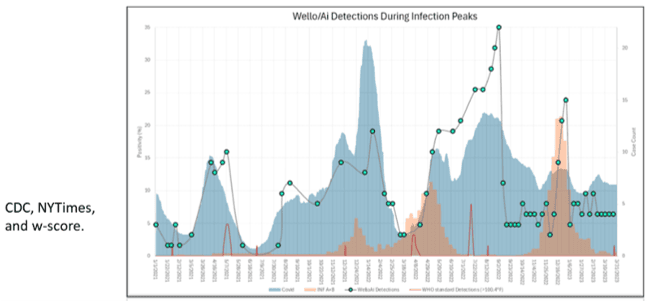
Managing disease spread in the workplace is responsible: it could be a life-or-death issue in high-risk environments like neonatal intensive care units (NICU), general intensive care units (ICU), emergency rooms, and high-risk senior care areas.
This blog explains the accuracy of the New Wello Protocol (NWP) from Wello AI in predicting the infectious spread of SARS-CoV-2 and influenza viruses based on body temperature scanning.
Let’s start with the science and data showing why anyone committed to infection control, especially in high-risk environments, can trust Wello AI to protect employees, patients, and business operations.
Control Infection Spread with the NWP from Wello AI
Control Infection Spread with the NWP from Wello AI
AI-driven temperature screening
AI-driven temperature screening
The NWP is an AI-driven process to reduce disease spread at work by identifying contagious employees whether or not they appear sick.
Wello AI runs on American-built automated, touchless FDA-Cleared Class II clinical thermometers that scan body temperature and identify by identifying contagious employees whether or not they appear sick.
Analyzing the Graph: SARS-CoV-2 and Influenza Positivity Against ANTEs
Study's Visual Validation of Regional
and Workplace Spread Based on w-score

Blue = SARS-CoV-2 (Covid) ; Red = Influenza; Green Dots = Wello AI Detections
This graph displays SARS-CoV-2 and influenza positivity rates alongside ANTEs (Above Normal Temperature Events). Let's break down the key points:
Peaks and Patterns
- SARS-CoV-2 Peaks: The blue areas represent SARS-CoV-2 positivity rates. Noticeable peaks occur during the winter and summer, aligning with the virus's behavior in low-humidity indoor environments created by air conditioning.
- Influenza Patterns: The brown areas show influenza positivity rates, peaking mainly during winter months, consistent with its seasonal nature.
- ANTE Effectiveness: The black line with orange markers indicates ANTEs collected by Wello AI running on welloStationXTM kiosks or desktop units. Peaks in ANTEs often precede or coincide with peaks in SARS-CoV-2 and influenza positivity rates, demonstrating Wello AI's effectiveness in early detection.
The summer peaks in SARS-CoV-2 are because air conditioning reduces
humidity, creating indoor environments conducive to the spread of SARS-CoV-2.
Control Infection Spread with the NWP from Wello AI
Control Infection Spread with the NWP from Wello AI
AI-driven temperature screening
AI-driven temperature screening
The NWP is an AI-driven process to reduce disease spread at work by identifying contagious employees whether or not they appear sick.
Wello AI runs on American-built automated, touchless FDA-Cleared Class II clinical thermometers that scan body temperature and identify by identifying contagious employees whether or not they appear sick.
Consistent Performance
The graph shows that during high ANTE activity periods, SARS-CoV-2 and influenza positivity rates are managed more effectively in any season.
Comparative Effectiveness
Comparative Effectiveness
The graph illustrates Wello AI’s superior effectiveness in early detection compared to relying on CDC and WHO temperature guidelines to indicate contagiousness.
Practical Implications for High-Risk Environments
Practical Implications for High-Risk Environments
Implementing Wello AI in high-risk settings like NICUs, ICUs, and senior care facilities can significantly enhance infection control by:
- Rapid Detection: Quickly identifying infections to prevent outbreaks in vulnerable populations, including newborns, critically ill patients, and at-risk seniors
- Consistency: Providing reliable data throughout the year, ensuring continuous protection and maintaining a healthy work environment
- Proactive Measures: Enabling immediate action based on accurate temperature screenings, allowing staff to address potential infections and safeguard patients and residents swiftly
The Above Normal Temperature Events (ANTEs) graph above illustrates why Wello AI’s advanced temperature screening technology is crucial to infection control.
By identifying peaks in SARS-CoV-2 and influenza positivity rates, especially in low-humidity environments created by air conditioning, Wello AI demonstrates its effectiveness in early detection and proactive infection management.
Implementing Wello AI in high-risk environments such as NICUs, ICUs, and senior care facilities significantly enhances the ability to control infection spread. The AI-driven process and FDA-cleared clinical thermometers provide consistent performance and reliable data throughout the year, surpassing traditional CDC and WHO temperature guidelines.
Wello AI enables rapid detection, year-round reliability, and immediate proactive measures, safeguarding vulnerable populations and ensuring healthy, safe environments. This technology is essential for early infection detection and effective management.
If you’re managing disease spread in the workplace based on symptoms, it’s too late. People are contagious whether or not they appear ill. Don't let one sick employee infect ten more. Minimize disease spread with the New Wello Protocol from Wello AI.
